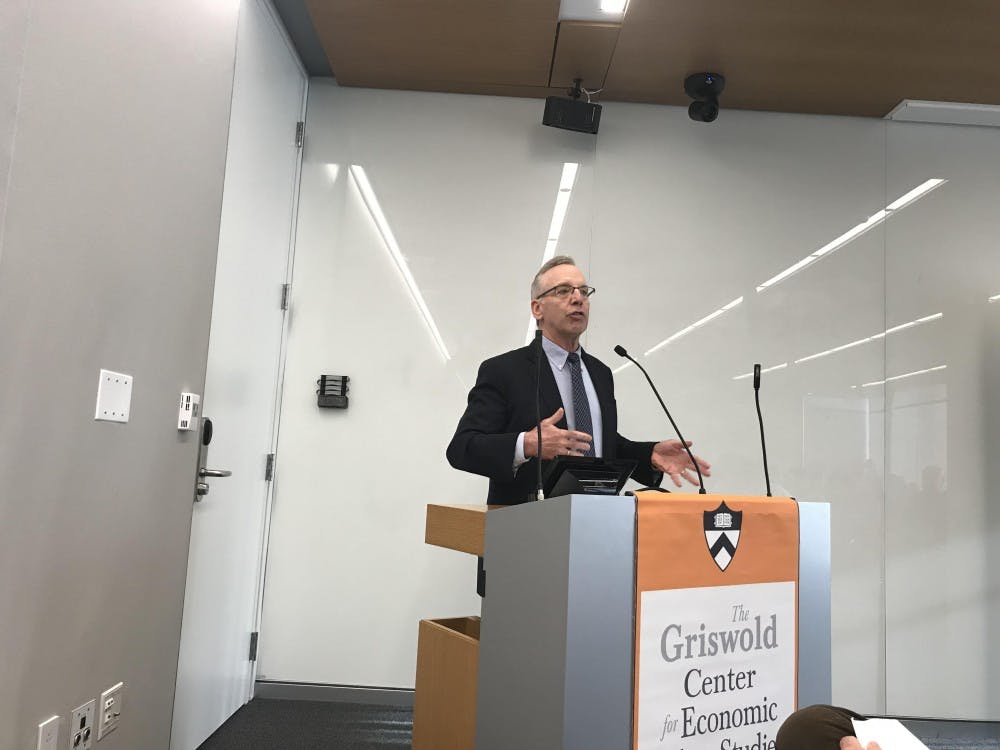In a lecture centered around economic expansion, former Federal Reserve Bank of New York President William Dudley addressed the question of whether or not the United States can keep the longest period of economic expansion in its history going.
In short, he asserted, it can.
On Thursday, Oct. 10, Dudley spoke in the Julis-Romo Rabinowitz Building about both the reasoning behind his optimism and the sources of any uncertainty. Dudley, presently a senior research scholar at the University’s Griswold Center for Economic Policy Studies, discussed past eras of economic expansion, the possible effects of ongoing trade disputes, and his views on the Fed’s current monetary policies.
In recent history, economic expansions have been getting longer, he explained. Dudley attributes this trend to an economy that is no longer a goods economy, but rather a service sector economy. The United States is now part of a global economy — meaning that there is more stability because another country can bear some of the weight of the United States’s economy faltering.
Dudley believes another reason for such long economic expansion is the depth of the previous recession.
“The deeper the recession, the higher the unemployment rate, meaning there’s more room to expand and grow,” Dudley said.
Additionally, a long economic expansion is possible because the unemployment rate can drop surprisingly low without inflation. While a few years ago, the Fed hypothesized that the lowest possible unemployment rate would be about 5 to 5.5 percent, the unemployment rate today is about 3 percent without any inflation problem.
“I think the outlook for expansion is still quite good,” Dudley said.

The financial and household sectors are thriving, there is solid job growth, wages are rising, and the housing market is recovering, according to Dudley.
He admitted, however, that there is still uncertainty. Dudley cites trade as the biggest source of economic uncertainty, which leads businesses to hesitate on making big investments.
A second major source of uncertainty is the question of how high tariffs will rise, with the Trump administration recently threatening to raise tariffs on all Chinese imports.
“The December tariff run is the most important one, because that’s when the Trump administration is threatening to put the tariffs on consumer goods, and those consumer goods cannot be relocated very easily … it would take them years to do that,” Dudley said.

Dudley said President Trump has strong incentives to remove the trade uncertainty, as it would benefit his campaign. He believes, however, that the Chinese government’s incentives have changed toward driving a harder bargain.
“I feel the incentives are to reach some sort of accommodation, but I thought that six months ago, and we haven’t gotten to that place,” said Dudley.
However, Dudley reasserted that the economic outlook is positive. After this discussion of tariffs, he spoke on what leads to economic recessions.
There are two main reasons economic expansions end, he said. The first occurs when the U.S. Federal Reserve strengthens monetary policy; the second is a sudden jolt to the economy. This first issue is not a problem right now, but the second may remain a possibility.
Many people cite the current flat yield curve as a bad omen, since a flat or inverted yield curve is historically a reliable sign of an economic recession. Based on the yield curve, the Fed estimates there is a 35 percent chance of recession in the next 12 months. We have no need to worry though, Dudley said.
“I don’t think the yield curve is flat because monetary policy is tight, I think the yield curve is flat because people are worried about recession, and they want to hold long-term treasury bonds,” he explained.
While people used to buy bonds because they were worried about inflation, people now buy bonds because they are worried about recession. Thus, the yield curve does not represent what it has in years past.
Another reason people worry about recession is the “turbulence” in the U.S. money market. The current upward pressure on money market rates mirrors the similar upward pressure in 2007, which foreshadowed the 2008 crisis.
“This time is different,” Dudley said. To avoid pressure, the supply and demand for reserves must simply be equal, and the Fed is implementing strategies to ensure this equality.
Dudley went on to defend the Fed’s current monetary policy, and to explain the split between those who want to tighten monetary policy, and those who want to keep it as is.
Dudley ended his speech by telling the audience to keep an eye on unemployment rates as well as foreign trade policy. “If the economy grows slow enough to cause the unemployment rate to rise a bit, the next thing is always recession,” he said.
Following the lecture was a Q&A session, where Dudley responded to questions about the national debt, the possibility of interest rates entering negative territory, the possibility of a banking crisis in China, and the difficulties posed by an aging population. The audience was then invited to a reception.








